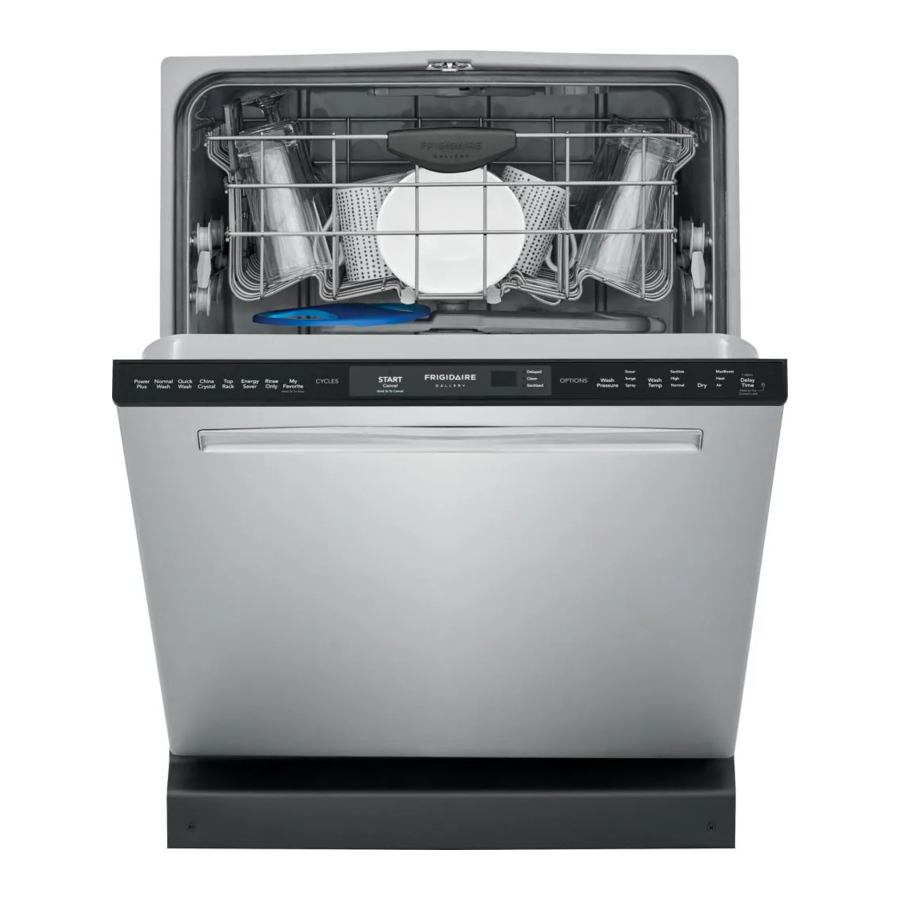


Please read all instructions before using this dishwasher.
To reduce the risk of fire, electrical shock or injury when using your dishwasher, follow the above basic precautions.
This symbols will help alert you to such dangers as personal injury, burns, fire and electrical shock.
Registering your product with Frigidaire enhances our ability to serve you. You can register online at www.frigidaire.com or by dropping your Product Registration Card in the mail.

NOTE
Why Energy Efficient Units run long cycles: Several factors are important to washing dishware. The energy use of the dishwasher was reduced by applying more of the factors that don't use so much energy and less of the ones that use more. As a result, you will see that the wash cycles take longer.

NOTE
The dishwasher is programmed to remember your last cycle so you do not have to reset each time. To start the dishwasher using the same cycle and options selected on the previous wash, just press the START/CANCEL pad.

NOTE
Not all cycles and options available on all models.

NOTE
Lights on the console will remain on once the door is shut and wash cycle begins. If it is preferred to have the lights turn off while cycle is running see Console Lights section for instructions.

NOTE
Very Important Information –Read Before Operating Your Dishwasher!
Normal Operating Sounds
This dishwasher does not sound like most dishwashers - IT'S QUIETER.
Your Direct Feed Wash System dishwasher uses energy efficient motors for the wash and drain portions of the cycle you select. Each cycle has a series of water fills and drains for washing and rinsing dishes. As each cycle begins, you may-or may not- hear the drain motor. The next sound you will hear is the splashing water as it enters the tub.
PLEASE BE ADVISED: If you compare this dishwasher to previous models, you may be surprised at what you DON'T hear.

NOTE
If the dishwasher door is opened while the unit is running, the START/CANCEL pad must be pressed and the door shut immediately to return the unit to the selected cycle and option, this must happen within 10 minutes for the unit to continue the cycle.
Your dishwasher cleans by spraying a mixture of hot water and detergent through the spray arms against soiled surfaces. First, the dishwasher fills with water covering the filter area. Water is then pumped through the spray arms. Soil particles go across the filter and down the drain as the water is pumped out. This series of steps are repeated as needed. The number of water fills vary with the cycle being used.
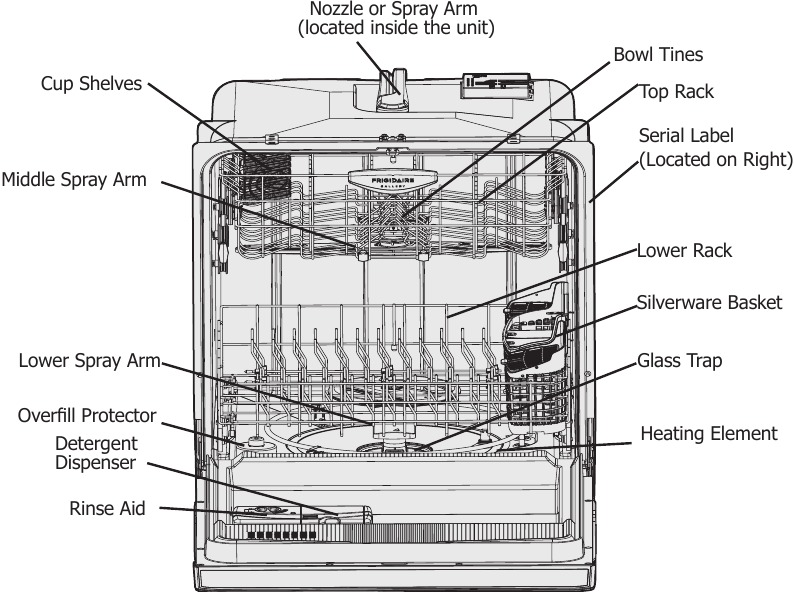
Features may vary according to model
Cycle times are approximate and will vary with options selected. Hot water is necessary to activate dishwasher detergent and melt fatty food soils. An automatic sensor will check the incoming water temperature and, if it is not hot enough, the cycle will be lengthened for automatic water heating in the main wash and final rinse of all cycles. This happens even when HI-TEMP WASH option has not been selected. When HI-TEMP WASH is selected, an even higher temperature will be reached to handle heavier soil loads.

NOTE
Lights on the console will remain on once the door is shut and wash cycle begins. If it is preferred to have the lights turn off while cycle is running see Console Lights section for instructions.
When HI-TEMP WASH option is selected, the dishwasher heats water in the main wash to approximately 140°F (60°C).
This increase in water temperature helps the dishwasher detergent remove food grease and soil from dishes more effectively and aids in drying. HI-TEMP WASH option is available on POWER PLUS, NORMAL WASH and TOP RACK cycles. HI-TEMP WASH is automatically provided when the POWER PLUS cycle is selected.
When HI-TEMP WASH option is selected, the indicator light will come on and remain on until end of cycle. To turn off the HI-TEMP WASH option, press HI-TEMP WASH a second time. The indicator light will turn off.
Use of the HEAT DRY option, especially in combination with use of rinse agent, will enhance drying. If AIR DRY is selected the heater will be de-activated during the drying phase of the selected wash cycle. This will slightly lower the energy use but will increase the likelihood that the dishware will not dry completely.
When MaxBoost Dry TM option is selected, the dishwasher extends drying time by approximately 20 minutes. The MaxBoost Dry TM option can be used with all cycles except CHINA CRYSTAL, ENERGY SAVER and RINSE ONLY. For best drying performance, also apply an increased wash temperature by selecting HI-TEMP WASH or even better, the SANITIZE option.
The energy required to use the MaxBoost Dry TM option costs pennies per cycle. You may choose not to select the MaxBoost Dry TM option; however you may have items in your dish load that will not be completely dry at the end of the cycle.
To sanitize your dishes and glassware, select the SANITIZE option. When selected, the indicator light will come on and remain on until the end of cycle. The water temperature in the final rinse will be raised to 156°F (69°C). This option is available in POWER PLUS, NORMAL WASH and TOP RACK Cycles. Only these sanitization cycles have been designed to meet NSF requirements.
The cycle time will be extended until the proper water temperature is reached. Washing action will continue during the water heating delay. For best results, the incoming water temperature should be at least 120°F (49°C).
The sanitize criteria may not be satisfied if there is an interruption of the cycle, power failure or if the incoming water temperature is below 120°F (49°C).
To turn off the SANITIZE option, press SANITIZE a second time. The indicator light will turn off.
The FAVORITE CYCLE option allows you to program your preferred cycle and options into one button. Once Programmed, simply select FAVORITE CYCLE and then select START/CANCEL. T
Program the FAVORITE CYCLE:
The display will flash for 2 seconds indicating the FAVORITE CYCLE option has been programmed. To change the FAVORITE CYCLE option simply repeat steps one and two above.
The DELAY START option allows you to automatically delay starting your dishwasher 1-24 hours.
To start the DELAY START option, press DELAY START until the desired delay time shows in the STATUS window. A light will come on indicating the delay has been set and will remain on until cycle starts. Press the START/CANCEL pad to start the delay option. If the delay option is interrupted, the START/CANCEL pad will have to be pressed again to return to delay option.
To cancel the DELAY START option and to begin the selected cycle before the delay period is over, press and hold START/CANCEL pad for 3 seconds.
You can cancel a cycle anytime during the cycle. Press and hold the START/CANCEL pad for 3 seconds. The light above the cycle and option selected will go out, and the START/CANCEL light will remain illuminated, the dishwasher will start a 90 second drain. At the end of the drain, select the next desired cycle.
To prevent children from accidently changing the dishwasher cycle or starting the dishwasher, to lock the dishwasher controls press and hold DELAY START for 3 seconds. An indicator light on the lock graphic pad will illuminate when the controls are locked and no new selections can be made until the lock is released. To unlock the controls, press DELAY START again for 3 seconds, and the indicator light will go out.
The console lights provide information about the cycle selection and current status. During operation, while the door is closed, these lights will remain on. At the completion of the cycle, the clean light will come on. The sanitization light will also come on if that option was selected and sanitization was achieved during the wash cycle.
The STATUS window, available on some models, indicates the following activity:
1H-24H: Number of delay start hours. The last hour will count down in minutes.
MINUTES: Number of minutes left in cycle (1-199).
CLOSE DOOR: Close door will scroll one time in the status window.
In the unlikely event that the dishwasher malfunctions, displays the error code "Uo", or gives poor performance you can call the Frigidaire Customer Care Center at 1-800-944-9044. They will be able to provide assistance in troubleshooting the problem and/or locating an authorized service technician, if needed.
If it is desired to have the console lights remain off while running, perform the following operation: Prior to starting a cycle, press and hold POWER PLUS and RINSE ONLY simultaneously for approximately 8 seconds until the corresponding lights flash. This will turn the console lights off during cycle operation. Simply repeat this operation to revert back to the previous setting.
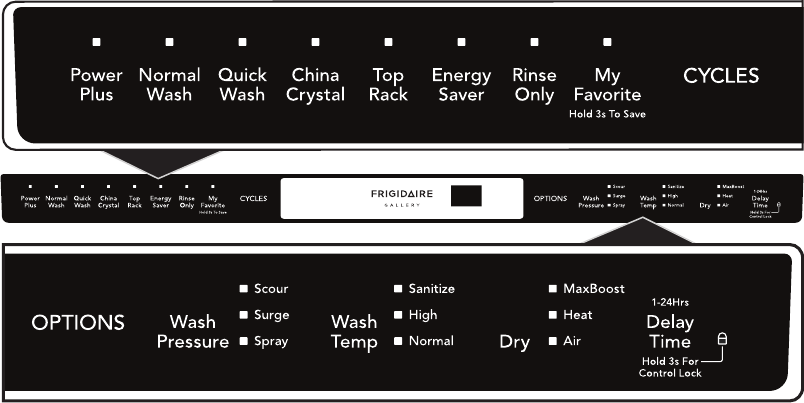
The DishSense TM Technology checks the soil level on your dishes in the POWER PLUS, NORMAL WASH TOP RACK and ENERGY SAVER cycles. In response, automatic cycle adjustments are made to assure the dishware gets clean - with less food the cycle gets shorter. Cycle time will also vary based on the options selected and the incoming water temperature. Not all cycles available on all models.
| Cycle and intended use | Available Options Pressure; Temperature; Drying | Water per Cycle | Duration* (approx.) |
| Power Plus* Recommended for pots, pans, casseroles and dinnerware having light to heavily soiled loads. | Scour, Surge; Sanitize, Hi-Temp; Sahara, Heat, Air | 7.1 - 9.4 gal. 27 - 36 L. | 2 3/4 - 4 Hours |
| Normal Wash* Recommended for lightly to heavily soiled loads. | Scour, Surge, Spray; Sanitize, Hi-Temp, Normal; Sahara, Heat, Air | 3.4 - 9.2 gal. 13 - 35 L. | 1 3/4 - 4 Hours |
| Quick Wash Recommended for lightly soiled loads only. | Surge; Normal; Sahara, Heat, Air | 5.4 gal. 20 L. | 34 Min. (Air Dry Only) |
| China Crystal Recommended for lightly soiled China, Crystal or other delicate items. | Surge, Spray; Normal; Heat, Air | 6.0 gal. 23 L. | 1 1/2 - 2 1/2 Hours |
| Top Rack* Recommended for small loads in the upper rack only that are light to heavily soiled. | Scour, Surge, Spray; Sanitize, Hi-Temp, Normal; Sahara, Heat, Air | 4.9 - 9.3 gal. 19 - 35 L. | 1 - 4 Hours |
| Energy Saver* Recommended for lightly soiled loads. | Scour, Surge, Spray; Normal; Air | 4.8 - 5.8 gal. 18 - 22 L. | 1 1/2 - 2 1/2 Hours |
| Rinse Only For rinsing dishware that will be washed later. | Surge | 2.5 gal. 9 L. | 16 Min. (Air Dry Only) |
* Cycle uses Soil Sensing feature to determine best Wash performance.
Scrape away large pieces of food, bones, pits, toothpicks, etc. The continuously filtered wash fluid will remove remaining food particles. Burned-on foods should be loosened before loading. Empty liquids from glasses and cups.
Foods such as mustard, mayonnaise, vinegar, lemon juice and tomato based products may cause discoloration of stainless steel and plastics if allowed to sit for a long period of time. Unless the dishwasher is to be operated at once, it is best to pre-rinse or use the RINSE ONLY cycle to rinse off these food soils.
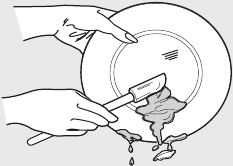
Features and appearance of racks and silverware basket as shown may vary from your model.
The upper rack is designed for flexibility in loading a wide variety of items including cups, glasses, stemware, small plates, bowls, etc.
Load glasses in top rack only. Damage may occur if placed in bottom rack.
Load plastic items in top rack only. Melting may occur if placed in bottom rack.
Load items with open ends facing down for better cleaning and draining.
Damage may occur if delicate items touch each other during dishwasher operation.
Long-handled knives and utensils can be placed in top rack.
Be sure nothing protrudes through the bottom of the rack to block rotation of middle spray arm.
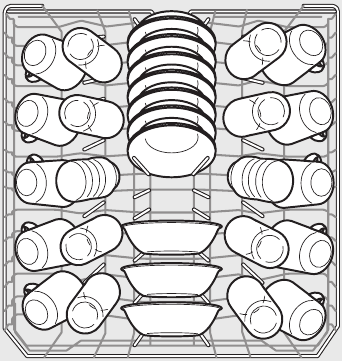
10 place settings standard loading pattern
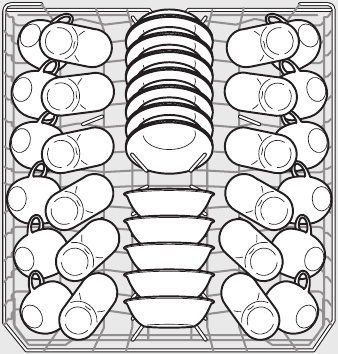
12 place settings standard loading pattern
Some models have a fold-down cup shelf or a cup shelf/stemware holder. They can be used to load two levels of cups, juice glasses, and other short items. Stagger items on upper level so that water can reach all inside surfaces. Fold up to load tall glasses.
The UPPER RACK cycle directs cleaning only to items in the upper rack and can be used to wash a wide assortment of items. It is useful for washing partial loads - especially when the upper rack fills up with glasses and the lower rack is still empty.
STEMWARE HOLDER/CUPSHELF not available on all models.
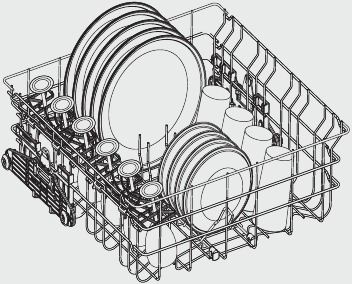
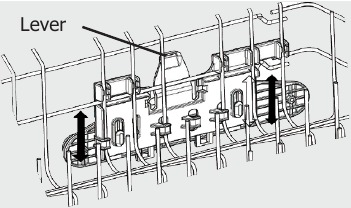
To raise the upper rack, refer to the figure below.
Press the lever toward the center of the rack and pull straight up on the rack.
To lower the upper rack, press the lever and push down on the rack.
The bowl times offer the ultimate in flexibility. When closed, load with saucers or small dishes. Open halfway and it is perfect for small casserole dishes. Open completely for those hard to fit items. As you load your dishwasher, you will find many other ways to use this unique feature.
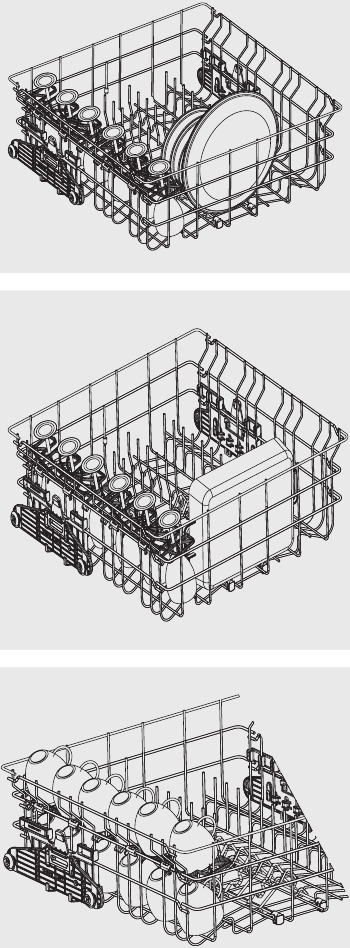
Rack Features and appearance of racks and silverware basket as shown may vary from your model.
The lower rack is best for plates, saucers, bowls, and cookware. Large items should be placed along the edge so they do not block the spray arm rotation. For best results, place bowls, casseroles, and sauce pans with soiled surface facing down and toward the center. Tilt slightly for better drainage.
Spin the middle spray arm to make sure that tall items do not block the rotation.
Be sure pan handles do not protrude through the bottom of the rack and block the lower spray arm rotation.
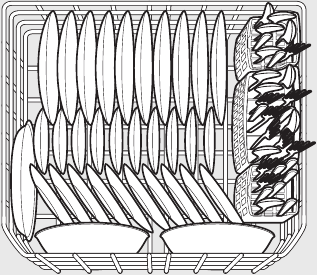
10 place settings standard loading pattern
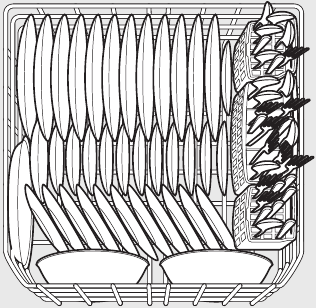
12 place settings standard loading pattern
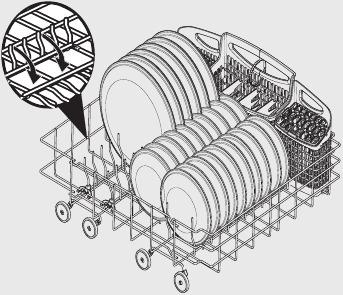
The fold-down tines in the lower rack make easy loading for those extra large and hard-to-fit items. The tines may be left up for normal use or folded down for more flexible loading. Fold down for more space to load large pots or pans.
Load sharp items (knives, skewers, etc.) pointing down.
Failure to do so may result in injury.
Features and appearance of racks and silverware basket as shown may vary from your model.
Load the silverware basket while it is in the bottom rack or take the basket out for loading on a counter or table.
For baskets with lids, small items like baby bottle caps, jar lids, corn cob holders, etc., can be placed in a covered section to hold them in place.
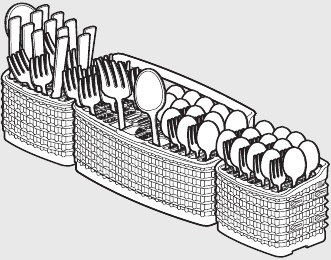
Use suggested loading patterns, as shown, to increase washability of the silverware.
Be sure nothing protrudes through bottom of basket or rack to block the spray arm.
To avoid damaging the silver finish do not mix silver and stainless.
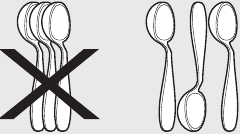
When covers are up, mix items in each section of the basket with some pointing up and some down to avoid nesting. Water spray cannot reach nested items.
To add or remove items after wash cycle starts:
Open the door very slowly & carefully if the dishwasher is operating. There is a risk of hot water squirting out.
The detergent dispenser has two detergent cups. The smaller one is for addition to the pre-wash and the larger is for release to the main wash.
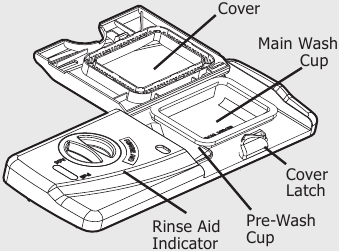
If the cover is closed on the Main Wash Cup open by pressing the Cover Latch.
The amount of detergent to use depends on the water hardness. Water hardness is measured in grains per gallon. Using too little detergent can result in poor cleaning and hard water filming or spotting. Using too much detergent in soft water can cause etching to some glassware which is surface damage that appears like a film but cannot be wiped off. Your local water company, water softener company or county extension agent can tell you the water hardness in your area.
The use of industrial grade detergent can damage the heating coil and other parts of the dishwasher leading to damage to the unit and surrounding property. Use only household grade automatic dishwasher detergents.
| Cycle | Soft Water (0-3 grains) | Medium Hard Water (4-8 grains) | Hard Water (9-12 grains) | Very Hard Water (Over 12 grains) |
| Power Plus or Normal Wash | 2 teaspoons (each cup- 1/4 full) | 5 teaspoons (each cup - fill to line above "Regular") | 8 teaspoons (each cup - completely full) | Each Cup - Completely Full (water softener recommended) |
| Top Rack, Quick Wash, China Crystal or Energy Saver | 2 teaspoons (Main Wash cup - 1/4 full) | 5 teaspoons (each cup - fill to line above "Regular") | 8 teaspoons (Main Wash cup - completely full) | Main Wash Cup- Completely Full (water softener recommended) |
| Rinse Only | No Detergent | No Detergent | No Detergent | No Detergent (water softener recommended) |
As a rule, use 1 teaspoon for each grain above 12. For very hard water, detergent alone may not be enough and then a water softener is recommended to improve water quality and dishwashing performance. However, when - using automatic dishwashing detergent tablets or packets simply place one in the main wash cup.
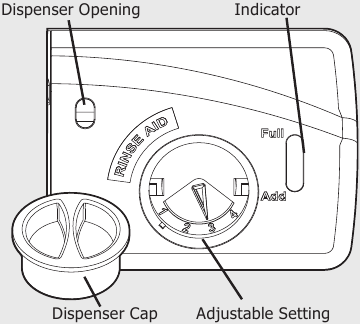
Rinse aid greatly improves drying and reduces water spots. With it water "sheets" off dishes rather than forming water droplets that cling and leave spots.
A dispenser, located next to the detergent cup, automatically releases a measured amount of rinse aid during the last rinse. If spotting and poor drying are problems, increase the amount of rinse aid dispensed by rotating the dial to a higher number. The dial is located under the dispenser cap. The indicator will be dark when full and will show clear when it is time to refill.
To add liquid rinse aid, turn dispense cap 1/4 turn counterclockwise and lift out. Pour in rinse aid until liquid touches the indicated fill level Replace cap.
Do not overfill since this can cause oversudsing. Wipe up any spills with a damp cloth.
The dispenser holds enough for 35 to 140 washes, depending on the dial setting.
The hot water line to dishwasher must provide water pressure between 20 and 120 psi.
Low Water pressure may occur when laundry or showers are in operation. If you experience poor wash performance you may need to wait until water use is reduced before starting dishwasher.
Hot water is needed for best dishwashing and drying results. Water entering dishwasher should be at least 120°F (49°C) to give satisfactory results.
To check water temperature entering dishwasher:
Before starting a cycle, run hot water to clear cool water from pipe.
The HEAT DRY option in combination with rinse aid will enhance drying performance. The energy required to use the HEAT DRY option costs pennies per cycle. You may choose not to select the HEAT DRY option; however you will have items in your dish load that will not be completely dry at the end of the cycle.
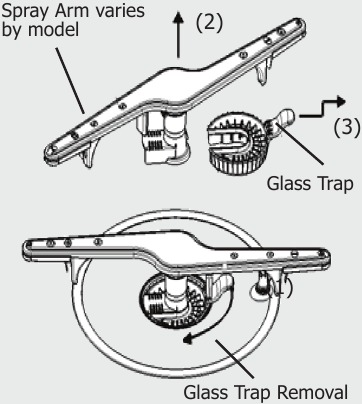

Burn Hazard
Allow heating element to cool before cleaning the interior.
Failure to do so can result in burns.
Clean outer door with warm soapy water and a dishcloth or sponge. Rinse with clean water and a dry cloth. Do not use harsh cleaners.
The inside of the dishwasher and filter are self-cleaning with normal use. If needed, clean around the tub gasket area with a damp cloth. The filter is self-cleaning. A glass trap located in the center of the filter is designed to collect pieces of broken glass, straws, bones and pits.
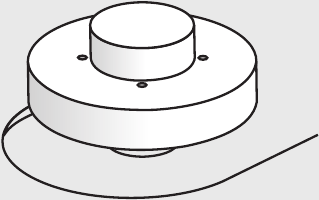
Overfill Protector keeps dishwasher from overfilling and is located in the left front corner of the tub.

NOTE
Hard water may cause lime deposit buildup on the interior of the dishwasher. For cleaning instructions see "Removing Spots and film" section.
If a drain air gap was installed for your built-in dishwasher, check to make sure it is clean so the dishwasher will drain properly. A drain air gap is usually mounted on countertop and can be inspected by removing the cover. This is not part of your dishwasher and is not covered by warranty.
Property Damage Hazard
Freezing temperatures may cause water lines to rupture. Be sure all supply lines to and circulating lines within dishwasher are protected.
Failure to do so could result in property damage.

NOTE
See Installation Instructions for more details on disconnecting and restoring service to your dishwasher.
A dishwasher left in an unheated place should be protected from freezing. Have a qualified person do the following:
Before calling for service, review this list. It may save you both time and expense. This list includes common experiences that are not the result of defective workmanship or material in your dishwasher.
Food Soils Left on Dishes
Dishes not Dry
Glassware/Flatware Spotted or Cloudy
Dishware Chipped
Vapor at Vent
Dishware Stained or Discolored
Water in Bottom of Tub
Cycle Takes a Long Time
Etching
Detergent Left in Cups
Dishwasher Leaks
Normal Sounds You Will Hear
Dishwasher Won't Run
Dishwasher Won't Fill
Dishwasher Does Not Drain Properly
Dishwasher has an Odor
Stains on Tub Interior
Opening the door during cycle
Removing Spots and Film
Hard water can cause lime deposit buildup on the interior of the dishwasher. Dishes and glasses may also get spots and film for a number of reasons. (See Glassware/Flatware Spotted or Cloudy section). To remove buildup, and film, clean using the following instructions:
Your appliance is covered by a one year limited warranty. For one year from your original date of purchase, Electrolux will pay all costs for repairing or replacing any parts of this appliance that prove to be defective in materials or workmanship when such appliance is installed, used and maintained in accordance with the provided instructions.
If You Need Service
Keep your receipt, delivery slip, or some other appropriate payment record to establish the warranty period should service be required. If service is performed, it is in your best interest to obtain and keep all receipts. Service under this warranty must be obtained by contacting Electrolux at the addresses or phone numbers below.
USA
1.800.374.4432
Frigidaire
10200 David Taylor Drive
Charlotte, NC 28262
Canada
1.800.265.8352
Electrolux Canada Corp.
5855 Terry Fox Way
Mississauga, Ontario, Canada
L5V 3E4

Here you can download full pdf version of manual, it may contain additional safety instructions, warranty information, FCC rules, etc.
Do you have a question about the Gallery Dishwasher that isn't answered in the manual? Leave your question here.
Thank you! Your question has been received!